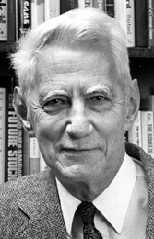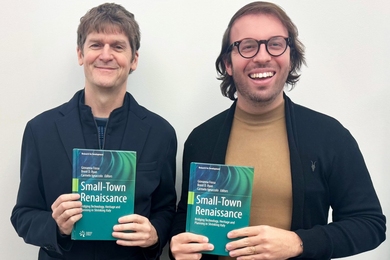Professor Emeritus Claude E. Shannon, known as the father of modern digital communications and information theory, died February 24 at the Courtyard Nursing Care Center in Medford after a long battle with Alzheimer's disease. He was 84 years old.
Professor Shannon, a distant relative of Thomas Edison, was affiliated with Bell Laboratories from 1941-72, during which time he wrote the landmark A Mathematical Theory of Communication (1948). This pioneering paper on information theory begins by observing that "the fundamental problem of communication is that of reproducing at one point either exactly or approximately a message selected at another point."
The information content of a message, he theorized, consists simply of the number of 1s and 0s it takes to transmit it. "Nobody had come close to this idea before," said MIT Professor Emeritus Robert G. Gallager, who worked with Professor Shannon. "This was not something somebody else would have done for a very long time."
The revolutionary idea was gradually adopted by communications engineers and stimulated the technology which led to today's information age. All communication lines today are measured in bits per second, the notion that Professor Shannon made precise with "channel capacity." His theory also made it possible to use bits in computer storage needed for pictures, voice streams and other data.
After receiving BS degrees in mathematics and electrical engineering from the University of Michigan in 1936, he came to MIT as a graduate student. As a part-time job, he worked on Professor Vannevar Bush's differential analyzer. His master's thesis, "A Symbolic Analysis of Relay and Switching Circuits," used Boolean algebra -- in which problems are solved by manipulating two symbols, 1 and 0 -- to establish the theoretical underpinnings of digital circuits. This work was the beginning of modern switching theory. Harvard University Professor Howard Gardner called it "possibly the most important, and also the most famous, master's thesis of the century."
He received the SM in electrical engineering and the PhD in mathematics from MIT in 1940. To satisfy the language requirement, he had to hire tutors in French and Spanish and worked repeatedly with stacks of flash cards. He had to take the German exam twice. Upon graduation, he became a research fellow at the Institute for Advanced Study in Princeton, NJ and joined Bell Laboratories in New Jersey in 1941.
During World War II, Dr. Shannon, a noted cryptographer, worked on secrecy systems at Bell Labs. His team's work on antiaircraft directors -- devices that observe enemy planes or missiles and calculate the aim of countermissiles -- became crucial when German rockets were used in the blitz of England. His 1949 paper entitled "Communication Theory of Secrecy Systems" is generally credited with transforming cryptography from an art to a science.
While at Bell Labs, he met Mary Elizabeth "Betty" Moore, a numerical analyst, whom he married in 1949. In 1956, Dr. Shannon became a visiting professor at MIT and the family settled on Mystic Lake in Winchester. He was MIT's Donnor Professor of Science from 1958-78, when he became professor emeritus.
Born in Petoskey, MI, on April 30, 1916, Professor Shannon grew up in Gaylord, MI, and worked as a messenger for Western Union while in Gaylord High School. He was a member of Tau Beta Pi.
WHIMSICAL INVENTIONS
Professor Shannon had a whimsical side and developed a juggling machine, rocket-powered Frisbees, motorized Pogo sticks, a mind-reading machine, a mechanical mouse that could navigate a maze and a device that could solve the Rubik's Cube puzzle. At Bell, he was remembered for riding the halls on a unicycle while juggling three balls.
An avid chess player, Professor Shannon built a chess-playing computer years before IBM's Deep Blue came along. While on a trip to Russia in 1965, he challenged world champion Mikhail Botvinnik to a match. He lost in 42 moves, considered an excellent showing.
Among his numerous awards were the National Medal of Science (1966), the Institute of Electrical and Electronic Engineers Medal of Honor (1966), and the Kyoto Prize for Basic Science (1985). He was a member of the American Philosophical Society, the National Academy of Sciences, the Royal Society of London and the Leopoldina Academy.
Professor Shannon received honorary degrees from Yale, Michigan, Princeton, the University of Edinburgh, the University of Pittsburgh, Northwestern, Oxford, the University of East Anglia, Carnegie-Mellon, Tufts and the University of Pennsylvania.
In addition to his wife, Professor Shannon is survived by a son, Andrew Moore Shannon of Brookline; a daughter, Margarita (Peggy) Shannon of Cambridge; a sister, Catherine S. Kay of Benton, KY, and two granddaughters. Services and burial are private.
A version of this article appeared in MIT Tech Talk on February 28, 2001.







